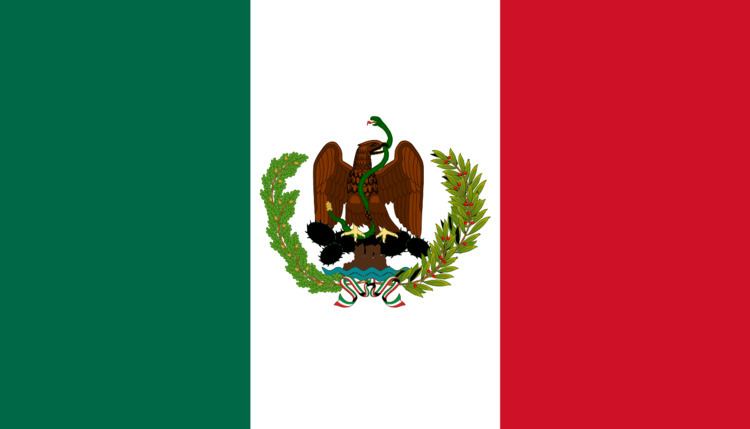Religion Roman Catholic | Government Federal Republic Founded 1823 Date dissolved 1835 | |
 | ||
1824–1829 Guadalupe Victoria (first) | ||
Mexico united mexican states
The First Federal Republic (Spanish: Primera República Federal) was a period in Mexican history corresponding to the first time in which both, republic and federation were established as form of government in the Mexican nation. Officially the United Mexican States (Spanish: Estados Unidos Mexicanos, listen ), it was bordered on the north by the United States and Oregon Country; on the south and west by the Pacific Ocean; on the southeast by Federal Republic of Central America, and the Caribbean Sea; and on the east by the Gulf of Mexico.
Contents
- Mexico united mexican states
- New considerations behind the fiscal failure of the first mexican republic 1824 1837
- Formation
- Independence and empire
- Early tension in the republic and civil war
- Texan Wars of Independence
- Mexican Federalist War
- References
The republic was proclaimed on November 1, 1823 by Constituent Congress, months after the fall of the Mexican Empire of Agustín de Iturbide. The federation was formally and legally established on October 4, 1824 when the Federal Constitution of the United Mexican States came into force.
The Federal Republic lasted almost twelve years with constant struggles between the main political parties: the Conservatives, landowners and former monarchists, favoring a strong central government and a confessional state; and the Liberals, republicans favoring a limited government power divided among the federated states and a secular nation. That caused a severe political instability and violence.
The republic was ruled by two triumvirates and nine presidents. Guadalupe Victoria, was the only president who completed his full term in this period and in almost 30 years of independent Mexico.
On October 23, 1835, after the repeal of the Constitution of 1824, the Federal Republic was changed by a Centralist Republic. The unitary regime was formally established on December 30, 1836, with the enactment of the seven constitutional laws.
New considerations behind the fiscal failure of the first mexican republic 1824 1837
Formation
In December 1822, Generals Antonio López de Santa Anna and Guadalupe Victoria wrote and signed the Plan of Casa Mata. This was an agreement between these two generals, amongst other Mexican generals, governors, and high-ranking governmental officials, to abolish the monarchy and replace it with a republic. Several insurrections arose in the Mexican provinces beginning in December, but they were all put down by the Imperial Army, except for Santa Anna's forces in Veracruz.
This was because Santa Anna had previously made a secret agreement with General Echávarri, the commander of the Imperial forces. By this agreement, the Plan of Casa Mata was to be proclaimed throughout Mexico on February 1, 1823, and Echávarri was to switch sides. This plan did not recognize the First Mexican Empire and called for the convening of a new Constituent Congress. The insurrectionists sent their proposal to the provincial delegations and requested their adherence to the plan. In the course of just six weeks, the Plan of Casa Mata travelled to such remote places as Texas, and almost all the provinces supported the plan.
Independence and empire
On September 27, 1821, after three centuries of Spanish rule and an 11-year war of independence, Mexico obtained its sovereignty. The Treaty of Córdoba recognized New Spain as an independent empire, which took the name of the Mexican Empire.
A minority of the Constituent Congress in search of stability chose as monarch the general Agustín de Iturbide who had led the war effort against Spain. He was proclaimed Emperor of Mexico on May 18, 1822. Soon after, problems arose between the emperor and the Constituent Congress. Several members were jailed simply for expressing their disagreement with Iturbide, and finally Iturbide decided to eliminate the elected Congress, establishing an appointed National Board in its place.
The dismissal of the Congress, the dictatorial style of government adopted by the Emperor, and the absence of solutions to the serious problems that the country was going through increased the conspiracies to change the imperial system. Antonio López de Santa Anna proclaimed the Plan of Casa Mata, which was later joined by Vicente Guerrero and Nicolás Bravo. Iturbide was then forced to reinstate the Congress, and in a vain attempt to save the order and keep the situation favorable to his supporters, he abdicated on March 19, 1823.
However, the restored Congress declared the appointment of Iturbide void ab initio, and thus refused recognition of the abdication. On 8 April, the Congress declared the Plan of Iguala and the Treaty of Córdoba void as well. With that the Empire was dissolved and the country declared its freedom to establish itself as it saw fit.
Early tension in the republic and civil war
Antonio López de Santa Anna, a former federalist turned centralist and eventual dictator, suspended the 1824 Constitution and replaced it with the Siete Leyes in 1835, a radical amendment that institutionalized the centralized form of government.
Several states openly rebelled against these changes. Northern Coahuila y Tejas, San Luis Potosí, Querétaro, Durango, Guanajuato, Michoacán, Yucatán, Jalisco, Nuevo León, Tamaulipas, and Zacatecas all disapproved. Civil war quickly spread across the Mexican states, and three new governments declared independence: the Republic of Texas, the Republic of the Rio Grande and the Republic of Yucatán.
Texan Wars of Independence
In May 1835 Santa Anna brutally crushed a revolt in Zacatecas and marched towards Coahuila y Tejas. In April 1836, he was defeated in Texas, where Texans retained their independence and formed a separate republic.
Mexican Federalist War
There were further battles in 1839: Acajete (May 3), Alcantra (October 3–4), and the siege of Tampico (May 26 – June 4); and two more battles in 1840 Santa Rita de Morelos—or Morales—(March 24–25), and Saltillo (October 25).
